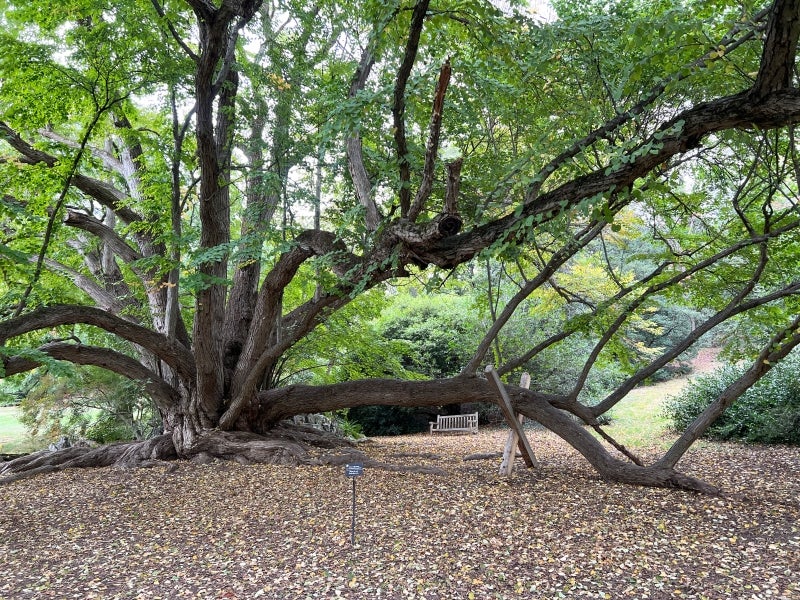Blog


If you’ve visited the majestic katsura-tree (Cercidiphyllum japonicum) in the last few weeks, you may have noticed the X-brace installed by our Arborist team. This support structure was added to help preserve one of the most significant and beloved trees at Morris Arboretum & Gardens.

In its native range of Japan and China, the katsura-tree is commonly found growing in temperate forests along streambanks, rivers, and other moist but well-drained soils. In autumn its bright yellow, heart-shaped leaves release a distinctive sweet scent—often compared to burnt sugar—as they senesce and drift to the ground, filling the air with a delicious fragrance. In 1898, John Morris acquired a young katsura-tree from the esteemed Veitch Nursery in London, making our specimen at least 127 years old. Today, our katsura-tree holds the title of Pennsylvania state champion for its species and is arguably the largest tree in the city of Philadelphia.
Chief Arborist Peter Fixler, dedicated to preserving Morris’s living collection, recently oversaw the replacement of several aging steel cables supporting the massive limbs of this tree. Two new cables were added to bolster the tree’s structural integrity, ensuring its continued stability. As part of this care, a large lower branch resting on the ground was also reinforced to prevent stress and preserve the tree’s graceful form.


On August 15, 2013, during a violent thunderstorm, one of the largest eastern leads of the katsura-tree fractured, partially detached from the truck and settled onto the ground. Remarkably, the limb has not shown any signs of decline in the years since. Instead, it has continued to grow while resting on three points of contact (Figure 2): one attached to the main stem of the tree, a second to the live part touching the ground, and a third on a now severely decaying dead branch.
With this third support point nearing the end of its structural life, the limb became increasingly vulnerable to twisting or breakage under wind or snow and ice loads. To mitigate this risk, Peter and his team installed an X-brace to serve as supplemental support, ensuring the continued stability and health of this massive, ground-reaching branch.
The idea to use the brace originated from Peter’s visit to England in June 2024. Supported by the Paul and Debra Meyer Extraordinary Experience Endowment—which provides travel scholarships to Morris staff for continued professional development—he toured ten sites and met with expert tree managers to learn how they care for their ancient tree specimens. While visiting Burnham Beeches, a 926-acre nature reserve and conservation area near the village of Burnham, Buckinghamshire, he encountered the X-brace (Figure 3) — a simple yet sturdy structural solution designed to support aging trees. Adaptable and unobtrusive, the concept could be modified to suit the katsura-tree’s unique form while preserving its natural beauty.
“Their trees are really old over there; we’re talking 300- to 800-year-old trees. It was a perspective-changing trip. I came back with more questions than answers. I learned a whole new vernacular. The knowledge I obtained can be applied here in certain situations for our older trees.” - Staff Q&A with Peter Fixler, Penn Today


When it came time to decide how to best support the compromised branch of the katsura-tree, Peter brought the X-brace concept to his team. Collaborating with the Facilities staff, they designed and installed a custom brace constructed from milled timber—sourced from a false cypress (Chamaecyparis) previously removed from the Morris collection. The resulting 6 x 10 support structure provides critical reinforcement while honoring the tree’s natural form. With this added stability, we hope our beloved katsura-tree will continue to thrive at the Morris Arboretum & Gardens for many years to come.
Want to learn more about Peter’s work as an arborist?
Watch his recent features on 6abc and NBC10!